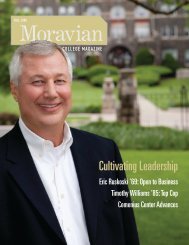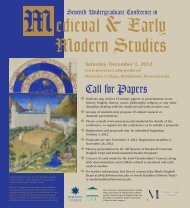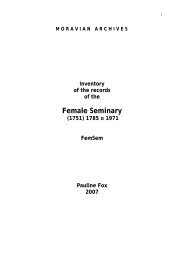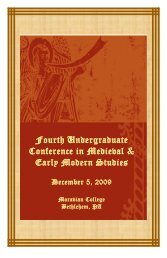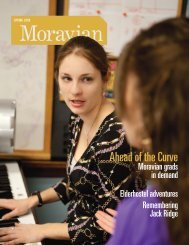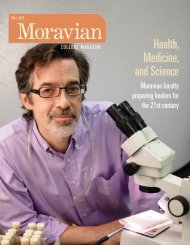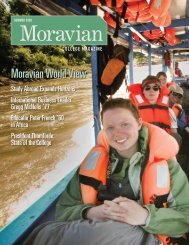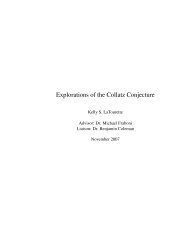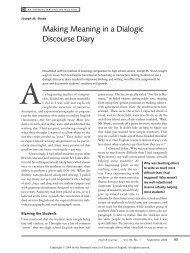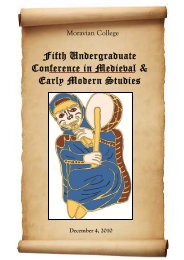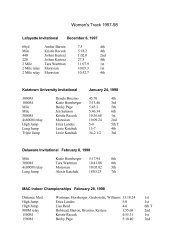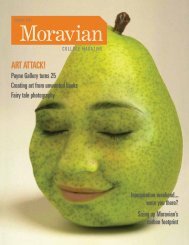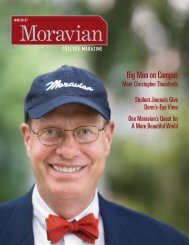Prelude: The Chipmunk Connection - Moravian College
Prelude: The Chipmunk Connection - Moravian College
Prelude: The Chipmunk Connection - Moravian College
Create successful ePaper yourself
Turn your PDF publications into a flip-book with our unique Google optimized e-Paper software.
SUMMER 2010<br />
<strong>Moravian</strong><br />
Words Count<br />
<strong>Moravian</strong> writers<br />
imagine, interpret,<br />
make meaning of our world
<strong>Moravian</strong>
summer<br />
2 <strong>Prelude</strong>: <strong>The</strong> <strong>Chipmunk</strong> <strong>Connection</strong><br />
By Lois Brunner Bastian ’60<br />
10 Of People and Places<br />
Joyce Hinnefeld, associate professor of<br />
English, speaks the language of landscape in<br />
her stories, poems, and essays.<br />
14 Not Your Mother’s Freshman Comp<br />
Effective writing requires more process, less<br />
rhetoric, says English professor Joel Wingard.<br />
16 Writers at the Center<br />
By nurturing ideas, the <strong>Moravian</strong> Writing<br />
Center develops better writers and thinkers.<br />
18 Brave New Words<br />
2010<br />
Sandra Novack-Gottshall ’98, whose first<br />
novel was published by Random House last<br />
year, is forging life as a writer of fiction.<br />
04 Out & About<br />
20 Alumni News<br />
22 Greyhound Sports<br />
23 Transitions<br />
24 Orbis Pictus: “Translation,”<br />
poem and artwork by Alexis Vergalla ’06<br />
See www.moravian.edu/magazine/extra for more from<br />
this issue.<br />
<strong>Moravian</strong> <strong>College</strong> Magazine : editor, Victoria Bingham;<br />
sports editor, Mark J. Fleming; web manager, Christie Jacobsen ’00;<br />
director of publications, Susan Overath Woolley;<br />
director of public relations and marketing, Michael P. Wilson.<br />
Creative Direction: Jane Firor & Associates.<br />
Alumni Relations: director, Marsha Stiles, M.B.A. ’99;<br />
assistant director, Patricia Murray Hanna ’82.<br />
Copyright 2010 by <strong>Moravian</strong> <strong>College</strong>. Photographs and artwork copyright<br />
by their respective creators or by <strong>Moravian</strong> <strong>College</strong>. All rights reserved.<br />
No portion of this publication may be reused or republished in any form<br />
without express written permission.<br />
Cover: Joyce Hinnefeld, associate professor of English and Cohen<br />
Chair in English and Literature, plans lessons, meets students, grades<br />
papers, and shapes language into stories in her Zinzendorf office.<br />
photo by John Kish IV<br />
Cover and Contents photos by John Kish IV.
p r e l u d e Stories from the <strong>Moravian</strong> community<br />
><br />
Courtesy of Nancy and Ben Evans<br />
2 MORAVIAN COLLEGE MAGAZINE SUMMER 2010
<strong>The</strong> <strong>Chipmunk</strong> <strong>Connection</strong><br />
By Lois Brunner Bastian ’50<br />
How could the lives of two <strong>Moravian</strong> <strong>College</strong> alumni—strangers<br />
who graduated more than fifty years apart—be linked by chipmunks?<br />
It sounds improbable, even impossible. But “uncanny” is a<br />
far better word to describe this story.<br />
It began many years after I graduated from <strong>Moravian</strong> <strong>College</strong><br />
for Women as an English major. In time, I became a freelance<br />
writer/photographer, publishing newspaper and magazine articles<br />
on travel and any other subject that piqued my curiosity.<br />
That’s when chipmunks bounded into my New Jersey backwoods<br />
and became an obsession. Appealing and unapproachable,<br />
they presented a challenge. I wanted to know more about their<br />
secret lives.<br />
When one of them took refuge in a downspout, I saw an opportunity<br />
to get closer. Holding out sunflower seeds in the palm of my<br />
hand, I would wait and wait by the mouth of the spout. One day,<br />
the animal snatched the food and bolted back into the spout. After<br />
that breakthrough, the spout became unnecessary. <strong>The</strong> chipmunk<br />
would come to me as I sat outside, cautiously climbing my leg, into<br />
my lap or onto my shoulder, wherever the food was.<br />
So began thirty seasons of observing, hand feeding, watching<br />
courtship and mating, as well as photographing a series of mothers<br />
together with their litters. Because the mother trusted me, so did her<br />
young ones, as I sat beside their burrow.<br />
Before the young left to make burrows of their own, I often<br />
spent eight hours a day watching their behavior. <strong>The</strong>y examined<br />
every leaf, blade of grass, and twig nearby. Trying to stand on their<br />
hind legs, they lost their balance at first and toppled over. That<br />
would take practice. <strong>The</strong>y teetered on twigs too slender to support<br />
them. Fluttering leaves and the shadow of a flying<br />
bird sent them fleeing underground.<br />
Books about the life cycle of Tamias<br />
striatus are plentiful, but I’d never found one<br />
describing a mother with her offspring. Hmmm<br />
. . . was there a market for such a book? In<br />
2000, <strong>Chipmunk</strong> Family, my nonfiction book<br />
for young people, was published.<br />
That seemed to culminate my wildlife<br />
experience. Until eight years later, when I<br />
received a poignant letter. It came from Nancy<br />
Evans, a stranger who lived in Lansdale, Pa.<br />
She explained that she and her husband, Ben,<br />
were the parents of David Evans, who was<br />
killed twenty-three days<br />
before his twenty-third<br />
birthday—and two weeks<br />
before he was to graduate<br />
from <strong>Moravian</strong>. Dave, a<br />
computer art and graphic<br />
design major, was awarded<br />
his diploma posthumously<br />
in May 2004.<br />
Nancy wrote to tell me<br />
how my story was woven<br />
together with Dave’s story. “He was very enamored of chipmunks,”<br />
she wrote. “When Dave went hiking with his older brothers, he<br />
wished he could catch one for a pet.”<br />
As a bereaved mother, she was trying to “stay connected to her<br />
son in any way and every way” she could. She and her husband<br />
spent time at a local arboretum, hoping chipmunks would appear,<br />
as if they represented a message from their son.<br />
For Christmas 2007, Ben ordered several chipmunk books for<br />
her. “He ran into months-long difficulty trying to purchase your<br />
book,” she wrote. “First they backordered it and he waited. <strong>The</strong>n he<br />
got notice that it was out of print. He gave up.”<br />
In April 2008, Nancy received a package in the mail. It was her<br />
husband’s Christmas gift to her: my book. “I opened it and read<br />
about you in the Meet the Author section. Well, I stopped in my<br />
tracks when I read, ‘Ms. Bastian was born in Bethlehem, Pa., and<br />
graduated from <strong>Moravian</strong> <strong>College</strong>.’”<br />
Dave’s classmates planted a tree on the Church Street campus in<br />
his memory. <strong>The</strong> Evans family comes to Bethlehem<br />
regularly to place a wreath beneath it. On<br />
one of their visits, we met, after I had moved<br />
back to Bethlehem.<br />
Nancy ended her letter with these words.<br />
“You, your background, and your book are to<br />
me another connection with my dear Dave, and<br />
I find joy in it! Thank you for the delightful<br />
look at these oh-so-charming animals. We are<br />
not strangers, but friends who met through a<br />
young man and a book.”<br />
That alone makes writing the book worth<br />
the effort. W<br />
Photo by Lois Brunner Bastian<br />
A book by Lois Brunner Bastian ’50 (above)<br />
was the basis for a healing friendship with<br />
the family of David Evans ’04 (page 2).<br />
SUMMER 2010 MORAVIAN COLLEGE MAGAZINE 3
out&a b o u t<br />
A Graduation Story<br />
David Fisher ’10, who graduated from <strong>Moravian</strong> with<br />
Honors in May, overcame a traumatic childhood to<br />
succeed academically.<br />
photo by grad images<br />
David Fisher ’10 could write a book about persistence in the<br />
face of adversity. <strong>The</strong> May 2010 <strong>Moravian</strong> graduate overcame<br />
a traumatic childhood that included homelessness to finish his<br />
<strong>Moravian</strong> years with dual degrees in psychology and sociology<br />
with Honors. He will enter grad school at Lehigh University this<br />
fall on a full scholarship, on his way to fulfilling his dream of<br />
becoming a professor.<br />
At <strong>Moravian</strong>, Fisher worked hard and rarely spoke of his<br />
past. For Professor Robert Brill’s psychology class, Fisher wrote<br />
a prize-winning research paper that suggested how Wegmans<br />
food markets could prevent the annual loss of $4 million in<br />
unscanned items beneath shopping carts. Psychology professor<br />
Dana S. Dunn was so impressed with Fisher that he invited him<br />
to co-author a research study and book review. Another <strong>Moravian</strong><br />
mentor, sociology chair Debra Wetcher-Hendricks, helped<br />
open the door for Fisher at Lehigh, where he will begin graduate<br />
study with a teaching assistantship in August.<br />
“I’m not genius smart,” said Fisher. “I study hard. I work<br />
hard. I do homework. I didn’t want to become a statistic.”<br />
Fisher’s story was featured in local and regional media, including<br />
ABC-TV Philadelphia. Read the Morning Call story<br />
at http://www.mcall.com/news/local/all-a1_mc-bethlehemdavid.7265780may16,0,1893721.story.<br />
HAPPENING . . .<br />
August 30<br />
First day of classes<br />
Students and professors get down<br />
to business (and biology, English,<br />
music, and other academic matters)<br />
in classrooms on both ends of the<br />
<strong>Moravian</strong> Mile.<br />
for more details, see www.moravian.edu/news, or call 610 861-1300<br />
September 25<br />
Family Day<br />
9:00 A.M.–7:00 p.m. • Something fun for<br />
everyone! Hockey, football, tailgating,<br />
Celtic Celebration party, and special<br />
interest sessions. Watch our website<br />
for online registration and more<br />
information.<br />
4 MORAVIAN COLLEGE MAGAZINE SUMMER 2010
June Guitar Classic<br />
Classical guitarists Duo Mellis (husband and wife<br />
Susana Prieto and Alexis Muzurakis, above) instruct<br />
and encourage a young student (right) at a master<br />
class given at the Bethlehem Guitar Festival. Festival<br />
founder and director John Arnold, <strong>Moravian</strong> artistlecturer,<br />
highlighted “Married Couples” for the<br />
event’s 10th anniversary.<br />
photos by john kish iv<br />
“Married Couples” filled Peter Hall with<br />
the sweet sounds of classical and steel string<br />
guitars paired with lute, piano, and voice<br />
in early June, marking the 10th anniversary<br />
of the Bethlehem Guitar Festival. Presented<br />
by the <strong>Moravian</strong> <strong>College</strong> Department of<br />
Music and C. F. Martin Guitar Co., the<br />
festival featured concert performances by<br />
multi-award-winning Duo Mellis (husband<br />
and wife Susana Prieto and Alexis Muzurakis)<br />
and Thom Bresh, son of the legendary<br />
Merle Travis. Four other duos also<br />
performed, and Martin Guitar’s Dick Boak<br />
spoke about Martin Signature Editions.<br />
Duo Mellis, which closed the festival<br />
with a Saturday evening concert, drew rave<br />
reviews for their “astounding sense of intimate<br />
communication.” Prieto of Spain and<br />
Muzurakis of Greece have been performing<br />
internationally together since 1999, and<br />
have been married since 1996. <strong>The</strong> couple<br />
performed a Spanish-flavored repertoire that<br />
included “Sonatina Canonica” by Mario<br />
Castelnuovo-Tedesco, Manuel de Falla’s flamenco-inspired<br />
“<strong>The</strong> Short Life,” and three<br />
dances by the Argentine composer Alberto<br />
Ginastera—all beautifully synchronized.<br />
Festival founder John Arnold, <strong>Moravian</strong><br />
artist-lecturer in classical guitar, directs<br />
the annual event, which includes a guitar<br />
expo, workshops, master classes, recitals,<br />
and concerts. Aspiring musicians—as young<br />
as elementary school age—have a rare<br />
opportunity to learn from the pros at the<br />
festival. This year, Duo Mellis conducted<br />
private master classes with young local musicians,<br />
while <strong>Moravian</strong>’s Arnold offered a<br />
workshop. Arnold is a member of the flute<br />
and guitar duo Two Part Invention, which<br />
records for Bummer Tent Records.<br />
Vist Our New Website<br />
October 27<br />
2010 Janet A. Sipple Lecture<br />
Foy Hall<br />
5:30 P.M. • “Globalization and Urbanization<br />
and the Risks to Women,” a lecture by<br />
Dr. Afaf I. Meleis, Margaret Bond Simon<br />
Dean of Nursing, University of Pennsylvania<br />
School of Nursing.<br />
Come home to <strong>Moravian</strong> online! Our newly redesigned website at http://www.<br />
moravian.edu will take you to all of your favorite campus places and keep you<br />
current with fresh news and information about faculty members and students.<br />
Through a comprehensive planning, design, and development process, we’ve<br />
created a site that features an attractive design, easily accessible information, and<br />
timely, relevant content. Our new site offers a vastly improved browsing experience for prospective and<br />
current students, parents, alumni, faculty members, staff, and friends of the <strong>College</strong>. Through clear entry points<br />
on the home page, you can reach information, forms, and other interactive content in a quick click or two.<br />
Rotating features designed to highlight the achievements of students and faculty provide a window into the<br />
vibrant life of <strong>Moravian</strong> <strong>College</strong>. Webmaster Christie Jacobsen ’00 developed the site after gathering input and<br />
feedback from the entire <strong>College</strong> community.<br />
SUMMER 2010 MORAVIAN COLLEGE MAGAZINE 5
out&about<br />
Celebrating 50 Years of<br />
<strong>Moravian</strong> Honors<br />
A <strong>Moravian</strong> scholars’ Hall of Fame gathered on campus<br />
this spring, as dozens of Honors alumni returned to<br />
celebrate the 50-year anniversary of the <strong>Moravian</strong><br />
Honors Program. Honors alumni, their guests, 2010<br />
Honors candidates, and faculty members paid tribute to<br />
the academic research program that launched more than<br />
750 alumni on rewarding paths of professional success<br />
and personal fulfillment. In Reeves Library, alumni<br />
signed bound copies of their Honors theses, spoke with<br />
students, and reconnected with faculty friends. <strong>The</strong><br />
informal signing ceremony was followed by an address<br />
in Prosser Auditorium given by Judith Share Yaphe ’66,<br />
whose Honors history research on American policy<br />
toward Palestine (advised by Daniel Gilbert, professor<br />
emeritus of history) became the foundation of her career<br />
as a top CIA analyst and university professor. Dinner in Peter<br />
Hall was followed by a music performance in Foy Hall.<br />
Judith Share Yaphe ’66 (right) signs her Honors thesis at the<br />
program’s 50-year anniversary celebration last spring. Upper<br />
right: John ’65 and Jan Whitfield Landis ’64 reminisce about Jan’s<br />
Honors history project and <strong>Moravian</strong> <strong>College</strong> days.<br />
Photos by john kish iv<br />
GUESTSPEAKING<br />
Photo by john kish iv<br />
James Lyon ’76:<br />
Clean Energy Now?<br />
“We are addicted to oil. We spend $1 billion per day to purchase oil overseas,<br />
money that many of our veterans say is being diverted to terrorist organizations. Yet<br />
even if we sunk a well in every square mile of our coastline, we still would not have<br />
enough oil to meet our demand. Clinging to relics of the industrial revolution weakens<br />
us in the 21st century.<br />
“We need to embrace a new era driven by clean energy, which will create jobs<br />
here and beat China to the economic punch. It is the right path. As conservationist<br />
Aldo Leopold said, ’a thing is right, when it tends to preserve the integrity, stability,<br />
and beauty of the biotic community.’ Our self interest is not enough at this point. What<br />
in God’s name are we leaving to our children? Are we so certain that the status quo is<br />
right, that we are willing to roll the dice?”<br />
—Jim Lyon ’76, National Wildlife Federation vice president for conservation policy,<br />
from his lecture “Beyond 40 Earth Days,” given at <strong>Moravian</strong> <strong>College</strong> on April 20, 2010.<br />
6 MORAVIAN COLLEGE MAGAZINE SUMMER 2010
Transformation of Collier Hall Begins<br />
<strong>The</strong> architectural firm Einhorn Yaffee<br />
Prescott (EYP) of New York has been<br />
selected by <strong>Moravian</strong>’s project leadership<br />
team to provide professional architectural<br />
and engineering services for the renovation<br />
and expansion of Collier Hall of Science.<br />
<strong>The</strong> Hall of Science houses the departments<br />
of biological sciences, chemistry,<br />
nursing, and physics and earth science.<br />
EYP was selected for its outstanding<br />
track record of success, including recent<br />
projects for Assumption <strong>College</strong>, Boston<br />
<strong>College</strong>, Boston University, and Cabrini<br />
<strong>College</strong>. “EYP exhibited a real<br />
excitement about working with<br />
us,” noted Kim Sherr,<br />
<strong>Moravian</strong>’s assistant<br />
director of planning<br />
and project management,<br />
and a member of<br />
the project leadership<br />
team. “<strong>The</strong>ir creative<br />
ideas and focus on<br />
academics and community,<br />
thoughts on the<br />
continuity of our academic program during<br />
construction, and commitment to designing<br />
a facility that reflects the new, but remains<br />
consistent with the old, won the day.”<br />
<strong>The</strong> preliminary work, over the next<br />
seven months, will include all pre-design<br />
activities such as confirming the academic<br />
program and project budget, preparation<br />
of civil drawings, providing various testing<br />
requirements, and developing fundraising<br />
materials. <strong>The</strong> next milestone will come in<br />
April 2011, when the pre-design will be<br />
complete. If funding is secured, the <strong>College</strong><br />
will move forward with a full design and<br />
anticipate completion by October 2014.<br />
“We have worked many years in<br />
preparation and are excited to move<br />
forward with this very important project,”<br />
noted President Christopher Thomforde.<br />
“Modernizing the Collier Hall of Science is<br />
the greatest priority for our facilities if we<br />
are to maintain and build on our new and<br />
successful curricular programs.”<br />
MORAVIANBOOKSHELF<br />
n Brand It Like Barack by Gary Kaskowitz, associate<br />
professor of economics and business, analyzes the success<br />
of Barack Obama’s presidential campaign from a<br />
marketing perspective. <strong>The</strong> campaign stands as a shining<br />
example of effective marketing strategies that can be<br />
employed by students, small businesses, and politicians of<br />
all affiliations to achieve their goals. Professor Kaskowitz<br />
offers actionable advice but reminds readers that delivery<br />
must follow promises. Otherwise, even the most effective<br />
marketer will fail to sustain the brand.<br />
n A new book in a series on the role of sports and athletes<br />
in American culture will be published this summer.<br />
Co-edited by Joel Nathan Rosen, associate professor of<br />
sociology, and David C. Ogden, associate professor of<br />
communication at the University of Nebraska at Omaha,<br />
Fame to Infamy: Race, Sport, and the Fall<br />
from Grace, is a compilation of essays about<br />
the public slide of once-cherished male sport<br />
icons. Professor Rosen and C. Oren Renick<br />
co-authored the essay “Inextricably Linked:<br />
Joe Louis and Max Schmeling Revisited.”<br />
n Heikki Lempa, associate professor and<br />
chair of history, and Paul Peucker, faculty<br />
associate and director of the <strong>Moravian</strong> Archives, have<br />
edited and contributed to a new book, Self, Community,<br />
World: <strong>Moravian</strong> Education in a Transatlantic World. <strong>The</strong><br />
anthology, published January 2010 by Lehigh University<br />
Press, includes contributions on the history of <strong>Moravian</strong><br />
education in the 18th and 19th centuries.<br />
SUMMER 2010 MORAVIAN COLLEGE MAGAZINE 7
out&about<br />
Lasting Legacy<br />
<strong>The</strong> revered old elm that once grew near Main Hall has<br />
returned to its Church Street roots. But instead of beautifying<br />
the street before Main Hall, as it did for more than 200<br />
years, the legendary tree now graces Main Hall’s parlor in<br />
the form of a one-of-a-kind table. Local woodworker Michael<br />
Kane contacted the <strong>College</strong> in 2007, after the tree was<br />
taken down because disease had made it a hazard.<br />
“I admired that tree for years,” Kane said. “<strong>The</strong> day it<br />
was cut down, I offered to make a table from some of the<br />
wood.” Kane smoothed the surface of the rough-cut slabs<br />
with a series of sandings, then applied seven coats of tung<br />
oil and two coats of wax. With its gnarly perimeter<br />
and distinctive knots, the finished 4-by-7-<br />
foot table captures much of the character of<br />
the original. It promises to be at the center of<br />
many gatherings of good cheer and warm fellowship<br />
for years to come.<br />
photo by michael wilson<br />
Henry Elms<br />
I was pleased to learn that the wood from the famous Church Street<br />
elm is being preserved (“From Tree to Table,” Summer 2009). This<br />
tree was not an American elm but an English elm—a rare species<br />
in this area. English elms have become associated with the Henry<br />
family, who, for five generations, operated the Henry Gun Factory<br />
at Boulton, just north of Nazareth, Pa. <strong>The</strong>re were two large<br />
English elms at the Henry homestead (in Jacobsburg, Pa.), which<br />
fell to Dutch elm disease some time ago. Across the road, there once<br />
were two ancient English elms at the John Joseph Henry house;<br />
these were more recently destroyed by the same disease. <strong>Moravian</strong>’s<br />
Church Street elm bears witness to the fact that Henry daughters<br />
attended the old Female Seminary.<br />
To my knowledge, the last standing Henry elm is on the grounds<br />
of the church in the village of Belfast, Pa. <strong>The</strong> Henrys helped to build<br />
this church and established a <strong>Moravian</strong> congregation there to serve<br />
workers at the nearby Henry Gun Factory. It is curious that there is<br />
no record of an English elm at Nazareth Hall, a <strong>Moravian</strong> school for<br />
boys that was attended by Henry sons.<br />
—Robert P. L. Frick ’49, Bethlehem, Pa.<br />
8 MORAVIAN COLLEGE MAGAZINE SUMMER 2010
LETTER FROM THE PRESIDENT<br />
Warm greetings to you from campus!<br />
Great energy and expectation filled<br />
Prosser Hall during Blue & Grey Days,<br />
when students of the Class of 2014<br />
came to campus to begin their journey<br />
into the future as members of the<br />
<strong>Moravian</strong> community.<br />
We have a strong cohort of new<br />
students. About 380 graduated from<br />
high school this past spring, roughly<br />
100 are transferring to <strong>Moravian</strong> from<br />
other institutions, and about 15 will<br />
re-enter after having taken a leave of<br />
absence to work, serve in the armed<br />
forces, or study elsewhere.<br />
New Greyhounds join our community<br />
just as 417 young men and women of<br />
the Class of 2010 have gone on to begin<br />
careers, graduate studies, and professional<br />
school. What a fine record of accomplishment<br />
they established in the classroom, on<br />
the athletic field, and in the concert hall!<br />
<strong>The</strong> Class of 2010 also made a mark in<br />
terms of giving. Fifty-six percent contributed<br />
to the Senior Class Scholarship, which<br />
is awarded to senior students who face<br />
a financial hardship that may preclude<br />
them from completing their studies. I hope<br />
you will follow the example of the Class<br />
of 2010 by making a contribution to the<br />
<strong>Moravian</strong> Scholarship Fund, if you have<br />
not already done so. Your annual contributions<br />
help keep the door of opportunity<br />
open for students of ability, promise, and<br />
achievement, through the awarding of<br />
scholarships and financial aid.<br />
In response to the challenges of the<br />
Great Recession, <strong>Moravian</strong> increased its<br />
financial aid budget by about 20%. This<br />
required us to make several difficult and<br />
painful decisions that affected some of our<br />
faculty and staff positions and programs.<br />
We have responded to the current financial<br />
uncertainties with prudence while exercising<br />
good stewardship of the <strong>Moravian</strong><br />
mission for the future.<br />
Over the past year, a group of faculty<br />
and senior administrators met weekly to<br />
consider the best ways to make the <strong>College</strong><br />
sustainable now and in the future. We<br />
asked the campus community to help us<br />
think through questions like, “What are<br />
our strongest programs, and how can we<br />
strengthen them for the future?” “What<br />
new programs might we offer?” “How<br />
can we communicate our rich educational<br />
experience more effectively to high school<br />
students and their parents?”<br />
Many wonderful and vibrant answers<br />
have arisen from asking these questions. As<br />
our answers become more clearly defined, I<br />
will keep you informed.<br />
In the meantime, we all agree that the<br />
<strong>Moravian</strong> educational experience builds<br />
><br />
a strong foundation for a student’s future.<br />
Students are challenged to grow intellectually.<br />
Students are prepared for the world of<br />
work through hands-on learning. Students<br />
develop personally to realize a deeper enjoyment<br />
of life.<br />
<strong>The</strong> life and mission of <strong>Moravian</strong><br />
continue to move forward, despite the real<br />
economic challenges that bear down upon<br />
all colleges and universities throughout our<br />
country. <strong>The</strong> radiant faces of our graduates,<br />
crossing the platform to receive their diplomas,<br />
and the hopeful faces of our incoming<br />
Class of 2014 remind us of what is most<br />
important. <strong>Moravian</strong> is on a mission that<br />
really matters!<br />
Thank you for your support!<br />
Christopher M. Thomforde, President<br />
SUMMER 2010 MORAVIAN COLLEGE MAGAZINE 9
Of People& Places<br />
Joyce Hinnefeld speaks the language of landscape<br />
through her stories, poems, and essays.<br />
PHOTOs BY john kish iv
oyce Hinnefeld, associate professor of English,<br />
Cohen Chair in English and Literature, and director<br />
of the <strong>Moravian</strong> <strong>College</strong> Writing Center, began writing<br />
as an undergraduate student at Hanover <strong>College</strong> in<br />
Indiana: “I took a creative writing class taught by Margie<br />
Stewart and got hooked.” She went on to receive graduate degrees<br />
in English from Northwestern University and the State University<br />
of New York at Albany, and began teaching at <strong>Moravian</strong> <strong>College</strong><br />
in 1997. She is the author of Tell Me Everything and Other Stories,<br />
a collection of short stories that won the 1997 Breadloaf Writer’s<br />
Conference Bakeless Prize, as well as the novel In Hovering Flight<br />
(Unbridled Books), which received wide critical acclaim. Her second<br />
novel, Stranger Here Below, will be published by Unbridled Books<br />
in October. Her short story “Benedicta, or a Guide to the Artist’s<br />
Resume” was recently accepted for publication by the literary journal<br />
<strong>The</strong> Literary Review.<br />
Dr. Hinnefeld’s ongoing interest in the relationship between<br />
people and their landscapes is the basis for her current project, an<br />
essay on land ownership issues in Pennsylvania and their impact on<br />
the Delaware River. She is collaborating with student Michael Watson<br />
’11 on the summer SOAR project “Knowing Our Place: Writing<br />
to Uncover, and Reconnect with, Community and Landscape.”<br />
Tell us about your new novel, Stranger Here Below. It’s basically the<br />
stories of three generations of women connected through two very<br />
interesting communities in Kentucky. One is a Shaker site, Pleasant<br />
Hill. <strong>The</strong> other is Berea <strong>College</strong>. <strong>The</strong> core of the story is the friendship<br />
between two girls—one white, one black—who are roommates<br />
at Berea <strong>College</strong> in 1961, a time of upheaval.<br />
Where did you get the idea for this story? My husband was interested<br />
in photographing Shaker sites and artifacts when we lived in<br />
upstate New York, near the Hancock Shaker village. So the summer<br />
we were married,1994, we traveled to Kentucky to check out the<br />
Shaker site, Pleasant Hill, and Berea <strong>College</strong>, which is famous for its<br />
crafts. I became intrigued with the idea of bringing together the two<br />
places in a novel. I was interested in what they would have been<br />
like in the ’50s and ’60s. In fiction, you can make connections that<br />
might not be there otherwise.<br />
Places inspire much of Hinnefeld’s writing. Above: walking on Bethlehem’s Sand<br />
Island with Lily, an American Eskimo Dog, sparks ideas for an essay about the<br />
Delaware River.<br />
How did you link them in your novel? I created a character, Georgia,<br />
who was born in late 19th-century Ohio and was the daughter<br />
of an abolitionist. As a student at Oberlin <strong>College</strong>, she falls in love<br />
with a black man, but her father forbids her to marry him. He<br />
sends her to teach at Berea, a new school founded on principles of<br />
racial equality. Georgia is an ardent believer in equality, so when<br />
the school backtracks on integration [due to a Kentucky law that<br />
SUMMER 2010 MORAVIAN COLLEGE MAGAZINE 11
Of People and Places<br />
From Stranger<br />
Here Below:<br />
“Pilgrim and<br />
Stranger, 1962”<br />
<strong>The</strong>y trotted her out like a show pony. A<br />
circus act. When they asked her to play, she<br />
played—the waltzes, Debussy, the Chopin<br />
Etude she’d mastered.<br />
<strong>The</strong>y reported on her perfect grade<br />
average before she began, every time. She<br />
was exceptional! A remarkable exception!<br />
Proof of something surely, of the school’s<br />
right mission. Virginal and pure to boot.<br />
Studious. Accomplished on the piano, on<br />
which she did not play race music, but the<br />
classics.<br />
Mary Elizabeth kept picturing that young<br />
man’s hands floating over the keys, from<br />
such a distance, from the faraway seats<br />
where she and Aunt Paulie were sitting. And<br />
yet she felt like she was right there, beside<br />
him, or somehow inside him, her hands<br />
his hands, glazing the keys like rainwater.<br />
Fingers like the legs of racehorses.<br />
She thought that if she could play the<br />
French composers and also, now, Stravinsky,<br />
the pieces Aunt Paulie regretted never<br />
learning, the music might somehow still be<br />
hers. Hers, and Aunt Paulie’s. Those years in<br />
Paris, that longing in Paulie’s chest, in both<br />
their chests, when they played. Sometimes,<br />
when she finished playing Chopin, Mary<br />
Elizabeth sat at the piano and wept.<br />
But a funny thing: She couldn’t play the<br />
Stravinksy. She knew now that she never<br />
would.<br />
prohibited integrated<br />
education], she defies<br />
the rules and continues<br />
to invite black<br />
students into her<br />
classroom. Eventually<br />
she is fired and ends<br />
up becoming a Shaker<br />
at the age of 40, when<br />
Pleasant Hill has only<br />
two other people in<br />
the community.<br />
Berea comes back<br />
into the story through<br />
the character of Vista,<br />
a single woman from<br />
the mountains, who becomes Georgia’s<br />
caretaker in her later years. Vista’s daughter,<br />
Maze, is a student at Berea <strong>College</strong> in 1961.<br />
I wanted to explore issues of race,<br />
women’s relationships, and spirituality and<br />
sexuality—because to become a Shaker,<br />
as Georgia does, is to forgo a sexual life.<br />
Georgia’s one great love has been forbidden,<br />
and she must try to make sense of this<br />
in spiritual terms.<br />
What is your research process? It’s fairly<br />
indiscriminate—you read and absorb and<br />
note anything that seems quirky or interesting.<br />
<strong>The</strong>n something gives you an idea<br />
and you pursue it. For this novel, I received<br />
an FDRC summer stipend my first year at<br />
<strong>Moravian</strong>, 1998. I went to both Berea and<br />
Pleasant Hill and read everything I could<br />
find in their archives—old newspapers,<br />
journals, log books. Pleasant Hill had this<br />
funny photo album that belonged to a family<br />
that had run an inn on the property. A<br />
lot of that material ended up in the novel.<br />
As I read and learned about Kentucky,<br />
I became so fascinated with the historical<br />
background that early versions of the<br />
novel included too much of it. My editor<br />
graciously pointed that out, and finally I<br />
could hear it from him. [She laughs.] But I<br />
feel that if you’re going to write historical<br />
fiction, you need to try to learn as much<br />
as possible about the place and time that<br />
you’re writing about. <strong>The</strong> peril is that you<br />
then want to teach everybody.<br />
I’m in that mode now—reading and<br />
researching, getting ready to write a per-<br />
sonal essay. It can be uncomfortable—you<br />
often feel like you’re spinning your wheels<br />
because you’re not writing. But ultimately,<br />
it’s what I have to do to feel like I’m ready<br />
to begin writing.<br />
How do you integrate all of the pieces into<br />
a single structure? This was a long, tortured<br />
process. I’ve been working on this novel for<br />
over 10 years, and it’s gone through many,<br />
many versions. It isn’t always like this. <strong>The</strong><br />
structure for In Hovering Flight became apparent<br />
to me fairly early, and it just worked.<br />
In the first version of this novel, I was<br />
using first person to tell the story of Mary<br />
Elizabeth, an African-American girl, and<br />
my agent at the time cautioned me about<br />
it. It’s a source of some concern to me—<br />
that I will be seen as co-opting her story.<br />
And I understand that. So, very early on, I<br />
changed to third person, and I think that<br />
was for the good.<br />
But I think that early uncertainty<br />
created a rocky path for deciding how to<br />
structure the book. When I rewrote it for<br />
the last time last summer, I cut some, and<br />
added new material about the friends and<br />
about Mary Elizabeth’s mother, Sarah. <strong>The</strong>n<br />
I just laid it out on the floor and thought,<br />
well, this ought to come before that. And I<br />
just took chunks and wove them together. I<br />
tweaked it some more, and I thought that’s<br />
it. It’s not a chronological order at all.<br />
What inspires your writing? Places. That’s<br />
where my novels seem to come from. I’m<br />
very interested in exploring topography and<br />
trying to capture the beauty of the languages<br />
of different places. I have another novel<br />
in mind, very unformed so far, but I know<br />
it will involve the city of Prague.<br />
Places, and events—historical moments.<br />
In In Hovering Flight, it was the resurgence<br />
of the environmental movement in the ’60s,<br />
and ’70s. Also, social justice issues. That’s a<br />
tricky one for a novelist. <strong>The</strong>re’s always the<br />
risk of being heavy-handed.<br />
Favorite authors? Alice Munro, who writes<br />
short stories almost exclusively—I think<br />
she’s brilliant. Marilynne Robinson, author<br />
of the novels Housekeeping, Gilead, and<br />
Home. Nicholson Baker, who wrote A Box<br />
12 MORAVIAN COLLEGE MAGAZINE SUMMER 2010
of Matches and <strong>The</strong> Anthologist, which I<br />
just read. It’s just lovely.<br />
I’m also a fan of the German writer<br />
W.G. Sebald, who blurs the lines between<br />
fiction and nonfiction genres. His Emigrants<br />
is a novel that reads like a memoir. I seem<br />
to be drawn to many of the post-war German<br />
writers.<br />
And I should mention C. E. Morgan, a<br />
great young writer who went to Berea <strong>College</strong>,<br />
author of All the Living.<br />
I always have a stack of things going—<br />
right now, I’m reading about efforts to<br />
dam the Delaware River for the essay I’m<br />
working on; poetry by Robert Frost, John<br />
Clare, William Carlos Williams; and Eric<br />
Freyfogle on law and property ownership<br />
in relation to environmental issues. And<br />
always the latest New Yorker magazine.<br />
What do you feel is most important to convey<br />
to students who desire to write? Seize<br />
every opportunity to fill your time with<br />
writing. Yes, you are busy now, but not like<br />
you will be later. Savor having the time to<br />
write—and, no matter how busy you become,<br />
reserve a block of time for writing.<br />
I also tell my creative writing students<br />
about the value of graduate school—it can<br />
give you that time to write, along with a<br />
community of people devoted to writing. It<br />
can be affirming.<br />
><br />
Is it difficult to transition from writing to the<br />
classroom to being at home as a mother and<br />
wife? Oh yeah, it’s just a crazy struggle and I<br />
don’t do it very well. [She laughs.]<br />
Almost everybody has that quandary.<br />
I wrote this piece called “<strong>The</strong> Paradoxes<br />
of Caring,” which is on my blog [http://<br />
inhoveringflight.blogspot.com/2009/01/<br />
paradoxes-of-caring.html]. It talks about<br />
the current tendency to over-parent. So<br />
many readers of In Hovering Flight are angry<br />
with Addie—they see her as a neglectful<br />
mother—and that always shocks me. I<br />
didn’t intend for her to be a bad mother.<br />
Maybe parents need to back off a little—let<br />
kids play in the creek.<br />
People often ask me, “How much of<br />
your writing is about you?” I always say,<br />
“none of it really.” But of course some<br />
things are. For Addie, the question is, how<br />
does she combine making her art with being<br />
a mother and being concerned about<br />
the planet?<br />
In my blog piece, I included a quote<br />
by Scott Russell Sanders that originally<br />
appeared in the Writer’s Chronicle. Essentially,<br />
he says that it’s a struggle—but also a<br />
gift—to balance all of these things: writing,<br />
parenting, teaching. And when I read that, I<br />
only felt a little bit like, “yeah, but you’re a<br />
man.” [She laughs.] It’s artfully put—and I<br />
feel that’s what I aspire to.<br />
I recently did a reading at the Northshire<br />
Books bookstore in Manchester,<br />
Vermont, and a former student gave me a<br />
lovely introduction. <strong>The</strong> woman was Tina<br />
Mabey [Weikart ’98]—she had an independent<br />
study in poetry with me. I remember<br />
that she was so in love with language—she<br />
devoured William Carlos Williams. That<br />
kind of exuberance is what you’re looking<br />
for in students who will go on to become<br />
writers—they love reading as much as<br />
they do writing. Because what you love,<br />
as a writer, is not the sound of your own<br />
voice—it’s bigger than that. A love of language<br />
. . . that’s what you’re looking for. W<br />
Joyce Hinnefeld discusses her short stories with<br />
Advanced Placement students at Easton High School.<br />
SUMMER 2010 MORAVIAN COLLEGE MAGAZINE 13
Photo by John Kish IV<br />
14 MORAVIAN COLLEGE MAGAZINE SUMMER 2010
Not Your Mother’s Freshman Comp<br />
Moder n English101 is more process, less rhetoric.<br />
By Joel Wingard<br />
First-year writing—or freshman composition as it used to be<br />
called—is the most widely required course in American higher<br />
education. Since a course of this type was first taught at Harvard<br />
in the 1870s, its main purpose has been to introduce students to<br />
the practice of academic writing—the kinds of writing students are<br />
likely to encounter throughout their college careers. Some 135 years<br />
later, the methods of teaching this course have changed considerably.<br />
A major force in making first-year writing what it is today was<br />
the process movement, which recognizes that most good writing,<br />
especially good academic writing, follows a process that involves inventing<br />
ideas, arranging them for expression, trying out that expression<br />
in an early draft, and then revising and editing until a paper is<br />
“finished.” Older models of instruction in first-year writing assigned<br />
students regular “themes” in which apprentice writers were expected<br />
to demonstrate competence in “rhetorical modes” such as narration,<br />
description, comparison, and argumentation. <strong>The</strong>se papers<br />
were typically due, in finished fashion, one week after an assignment<br />
was given or even at the next class meeting. And the evaluation of<br />
student writing most often focused on its correctness in terms of<br />
grammar, spelling, and writing mechanics, such as punctuation.<br />
But in the 1970s and ’80s that method began to change as<br />
teachers and composition scholars realized that rhetorical modes<br />
were artificial and that no one—other than a first-year writing<br />
student—ever purposely wrote to demonstrate competency in<br />
comparison-and-contrast, for instance.<br />
Studies in the writing practices of professional writers have<br />
shown that written prose is driven by the purposes of the writer<br />
and the needs of the audience, and that it often takes several drafts<br />
of an essay with the attendant revision to each draft—to make it<br />
what the writer wants and what the reader needs.<br />
An influential book by composition scholar Peter Elbow, Writing<br />
Without Teachers, in the early 1970s contributed to a shift in<br />
writing teachers’ roles from “sage on the stage” to “guide on the<br />
side.” Instead of being a classroom figure who tells students what to<br />
do and how well they have done, the writing teacher now facilitates<br />
student development by coaching the writing process.<br />
This involves providing feedback—not just grades—to student<br />
writers as they work on an essay: talking over a student’s ideas for<br />
an essay before she ever sits down at her keyboard; commenting on<br />
a preliminary draft so that the student can make revisions herself;<br />
creating writing groups in a class and guiding them in “writerly”<br />
ways of reading each other’s work; and perhaps most especially, attending<br />
to deeper matters of a piece of writing—structure, development,<br />
consistency—and leaving attention to correctness until the<br />
piece is nearly finished.<br />
It follows that the students’ writing is the central text in the<br />
class: student writing is what is primarily practiced, produced, and<br />
studied. Any other writing, such as essays by professional writers, is<br />
secondary and used only to exemplify writing strategies or provide<br />
intellectual context for the students’ work. First-year writing<br />
courses are writing courses, not literature or history or political<br />
science courses in disguise.<br />
Traditionally, first-year writing was taught by English faculty<br />
members, based on the premise that their training in the belletristic<br />
canon gave them responsibility for student literacy. In recent years,<br />
however, many small liberal arts colleges “decentralized” first-year<br />
writing beyond the English Department. At <strong>Moravian</strong>, this occurred<br />
with the institution of the Learning in Common (LinC) curriculum<br />
in 2001. A typical semester at <strong>Moravian</strong> would have sections of<br />
Writing 100 (the required course) taught by biologists, psychologists,<br />
musicians, political scientists, economists, mathematicians—<br />
in short, faculty from a variety of disciplines other than English.<br />
Now, first-year students can see that writing is an important way of<br />
knowing in every academic field, not just in English.<br />
<strong>The</strong> teaching of first-year writing continues to evolve. Starting<br />
in fall 2011, the course will be called First-Year Seminar. <strong>The</strong> crossdisciplinary<br />
model will continue, but the faculty members who<br />
teach the class also will serve as academic advisors to the students<br />
enrolled in their sections.<br />
This makes sense because the approach to teaching this course<br />
encourages close student-faculty interaction anyway, and a first-year<br />
writing student often gets closer to his instructor than a student in<br />
a lecture or lab course might. And the notion of “writing” itself is<br />
broadening and changing to include digital media and genres, so<br />
one would expect to see not just print essays developed in first-year<br />
writing, but audio essays and video mash-ups as well.<br />
Even with these anticipated changes, the process approach<br />
continues to be well suited to helping students develop the clear<br />
thinking and clear writing they will need throughout their college<br />
years and beyond. W<br />
Joel Wingard is professor of English and director of the Writing-across-the-Curriculum Program.<br />
Taught by faculty members of all disciplines, <strong>Moravian</strong>’s Writing 100 develops<br />
writing skills that students will use througout college and beyond. Shown:<br />
Jennifer Gillard ’07<br />
SUMMER 2010 MORAVIAN COLLEGE MAGAZINE 15
Writers at the Center<br />
Focusing on ideas, not punctuation, develops better thinkers and writers.<br />
By Meg Mikovits ’03<br />
Photos by John Kish IV<br />
Many students who visit the Writing Center for the first<br />
time enter the room with one of two misconceptions:<br />
either they expect to drop off essay drafts and later<br />
pick up revised, edited copies ready to be submitted to the<br />
professor; or they steel themselves to face tutors who will<br />
barely be able to conceal their disdain for unsophisticated<br />
first-year writers, all while fixating on draconian grammar<br />
and mechanics rules.<br />
Neither of these beliefs is true, of course, and both actually<br />
run counter to the goal—shared by <strong>Moravian</strong>’s Writing<br />
Center and hundreds of others—espoused by Stephen North<br />
in his landmark 1984 essay, “<strong>The</strong> Idea of a Writing Center.”<br />
“In a writing center,” asserts North, “the object is to make<br />
sure that writers, and not necessarily their texts, are what<br />
get changed by the instruction.”<br />
Writing tutors aim to help writers become more comfortable<br />
with their own writing process and style—not to<br />
impart the tutor’s own preferences on a paper or to provide<br />
judgmental commentary about a writer’s shortcomings.<br />
Writing Center visits generally are relaxed and informal.<br />
Tutor and writer sit side-by-side, and the writer retains<br />
control of the paper and pencil (or computer) throughout<br />
the session. <strong>The</strong> writer explains the assignment, shares any<br />
areas of concern, and then reads the paper aloud. <strong>The</strong> tutor<br />
will take notes or sometimes interject to ask questions as<br />
the paper is read. <strong>The</strong> real work happens throughout the<br />
remainder of the session, when the tutor and writer discuss<br />
the paper. Talking about the ideas contained in a paper,<br />
rather than focusing on the specific words written, is a<br />
highly effective way to make sure a paper’s content is logical,<br />
organized, and appropriate for the assignment. Usually,<br />
the writer leaves with copious notes and a solid plan for<br />
further revisions; ideally, the writer and tutor meet again to<br />
review the revised draft before the paper is due.<br />
Writing Center tutors are an integral part of this system.<br />
All of our tutors, predictably, are strong writers. Beyond<br />
Get it in writing: at the Writing Center, tutors and writers discuss ideas first.<br />
16 MORAVIAN COLLEGE MAGAZINE SUMMER 2010
that, though, they are friendly, assertive,<br />
and creative. Tutoring demands the<br />
ability to work with writers of differing<br />
abilities, assignments from every academic<br />
department, and papers in varying<br />
stages of development—often in back-toback-to-back<br />
tutoring sessions over the<br />
span of a few hours. Tutors are also relentless<br />
supporters of the writing process,<br />
and will help writers understand how<br />
time spent brainstorming and prewriting<br />
can greatly impact the effectiveness of a<br />
paper. <strong>The</strong>y often use creative revision<br />
strategies to appeal to a writer’s interests<br />
and learning style. It’s not unusual to<br />
see tutoring sessions where papers are<br />
colored with highlighters or crayons, or<br />
literally cut apart and shuffled around.<br />
Writing centers teach writers how to<br />
be resourceful, interactive, and critical<br />
thinkers. We tell writers that what they<br />
do in the Writing Center can and should<br />
be applied to any writing task, in class and at home.<br />
A student in my Writing 100 class last semester showed the impact<br />
the Writing Center can have, beyond the grade on a given paper.<br />
This student had visited the Writing Center many times of her<br />
own volition, and she was a good writer—not exceptional, though<br />
certainly not weak. What made her stand out among the rest of the<br />
class was her performance during our in-class peer workshop sessions.<br />
Rather than offering bland advice about comma placement<br />
and word choice, she dove into the content of her peers’ papers and<br />
offered helpful and insightful feedback about content and organization.<br />
She asked probing questions and was able to elicit thoughtful<br />
responses; she and her peer workshop group consistently made<br />
great strides from their drafts to their formal essay submissions.<br />
As someone who tutored for many years before teaching composition,<br />
I am especially aware of the potential synergy between the<br />
writing classroom and the Writing Center. I encourage my students<br />
to visit the Writing Center at various stages of the writing process,<br />
and I try to give my composition students a crash course in writing<br />
center pedagogy. This, I hope, lets students know why the act of giving<br />
and receiving feedback is valuable, especially in a writing class<br />
that emphasizes a process-based approach to writing. Though many<br />
><br />
students at first find it easy to fall back on the easier and safer tactic<br />
of proofreading each others’ papers for punctuation and spelling,<br />
it is clear that the students who do utilize the Writing Center find<br />
themselves involved in a far more engaging learning experience. W<br />
Meg Mikovits ’03 earned her M.A. in English from West Chester University in 2006. Next year, she will<br />
serve as director of the <strong>Moravian</strong> Writing Center.<br />
SUMMER 2010 MORAVIAN COLLEGE MAGAZINE 17
Brave New Words<br />
Sandra Novack-Gottshall ’98 forges life as a successful fiction writer.<br />
By Kate Helm ‘05<br />
><br />
S<br />
andra Novack-Gottshall ’98 doesn’t want to write—she needs<br />
to. She compares her devotion to writing to that of a friend for<br />
her son who is going through the “terrible two” stage.<br />
“Once something is yours, and you love it, and it’s in your<br />
bones and blood and heart and head, you can’t just give it up when<br />
things become rough,” she says. “I wouldn’t stop focusing on writing<br />
or fiction any more than she’d give up her son. It doesn’t work<br />
like that.”<br />
Indeed, the fiction industry can be unpredictable. Random<br />
House published her first novel, Precious, last year. Despite the<br />
struggling economy and shake-ups at the publishing house, Precious<br />
was hailed as a top ten debut novel of the year. With a collection<br />
of short stories set to be published next year and work<br />
underway on a new novel, Resurrection Fern, Novack-Gottshall<br />
is quick to point out that accolades are not necessarily a reliable<br />
forecast of future success.<br />
“I’m harder on myself than anyone else is or ever could be,<br />
and whatever successes I have never seem to be good enough,”<br />
she says. “Not everything in a writer’s life comes down to one<br />
book or even two, but rather the entirety of the career. Writers<br />
are built over lifetimes, not a single book or event. Again,<br />
you go back to basics after everything is said and done: you<br />
get up, you write.”<br />
Although she writes predominantly in the morning,<br />
inspiration keeps her on-call, often striking in the middle of<br />
the night. She also gets new ideas from her reading; other<br />
writers are the best mentors, she says. A self-described<br />
recluse, she believes that tendency is an integral part of<br />
her life as a fiction writer. In order to breathe life into another<br />
world, she has to disengage from her own reality.<br />
“[Writing] takes time, physical time, during which<br />
you are away from other people and other things,” she<br />
explains. “With a short story, you might go a week or more before<br />
your mother calls and asks why she hasn’t heard from you. When<br />
writing a novel, you might go months ignoring friends, more or<br />
less, and cutting your social engagements down to practically nonexistent<br />
status. And then there is the psychological aspect of it: the<br />
deeper you are into a novel, the more ‘there’ rather than ‘here’ you<br />
are. Writers get called anti-social a lot, but really I think it’s necessary<br />
to the craft.”<br />
<strong>The</strong> trade-off for those sacrifices comes in the cathartic release<br />
of thoughts and emotions the page provides. Novack-Gottshall<br />
18 MORAVIAN COLLEGE MAGAZINE SUMMER 2010
dedicated Precious to her sister Carole, who left home<br />
when the writer was seven. At first, she thought she<br />
was writing to organize her fuzzy memories of her<br />
sister, but in the end realized the book was a chance to<br />
say goodbye. But the book was not directed at Carole;<br />
rather, it had a broader scope.<br />
“Fundamentally, I write because I have something<br />
I want to say, something I’m trying to get at, some<br />
truth about what it means to live in this world and<br />
be human,” she says. “<strong>The</strong>n I always hope what I’ve<br />
said finds an audience. I think books are radical. <strong>The</strong>y<br />
recreate the world and, in the process, they recreate us<br />
as well. Through the power of words, worlds are destroyed,<br />
created, re-envisioned; characters come to life,<br />
and they love and hate and learn things and live and<br />
die. It’s necessary to encounter and to try and understand<br />
all different types of people, situations, and lives.<br />
Fiction is one of the best ways we can do that.”<br />
As a psychology major at <strong>Moravian</strong>, Novack-Gottshall unknowingly<br />
began honing her insights into the human experience,<br />
which would serve as a springboard for the characters and worlds<br />
she creates. Robert Brill, associate professor of psychology, and<br />
Joseph Gerencher, emeritus professor of earth science, had a special<br />
impact on her undergraduate years.<br />
“Dr. Brill was always a great guy, supportive, helpful. And Dr.<br />
Gerencher was so dedicated and took time with all his students, not<br />
just science majors,” she says. “I always appreciated that. He was<br />
probably my favorite teacher at <strong>Moravian</strong>, even though I couldn’t,<br />
and still can’t, calculate the elliptical orbit of planets to save my life.”<br />
Although Novack-Gottshall took a winding path to becoming a<br />
writer, every choice she made always brought her back to the page.<br />
“At some point, I thought, ‘I am a writer.’ It’s me, it’s what I do,”<br />
she says. “And once that’s in you—really in you—discouragement<br />
about the industry or a difficult writing day aren’t enough to sway<br />
you. I’ve made a choice to write; we’re defined by our choices. And<br />
when I commit to something, I focus on it.”<br />
Precious will be released in paperback August 31. For more on<br />
Novack-Gottshall, visit her website at www.sandranovack.com or<br />
her blog at www.blahblahblahwriter.blogspot.com. W<br />
Kate Helm ’05 is a freelance writer and admissions officer at Northampton Community <strong>College</strong>. She<br />
lives in Easton, Pa.<br />
Born in Bethlehem, Pa., Sandra Novack-Gottshall ’98 now lives and<br />
writes in Chicago. Her acclaimed novel, Precious, will be released in<br />
paperback Aug. 31.<br />
Storied Alumni<br />
Many authors of published fiction honed their writing skills at<br />
<strong>Moravian</strong> <strong>College</strong> (or an earlier version of it); they include:<br />
Laura Benet (1884-1979), newspaper editor, poet, novelist;<br />
sister of Stephen Vincent Benet and William Rose Benet<br />
Nancy J. Jones ’77, fiction writer and women’s studies instructor<br />
Scott Morro ’95, children’s book author<br />
Scott Heydt ’02, author of novels for children<br />
This is only a partial list of our alumni authors. If you have a<br />
recently published book (fiction or non-fiction), please share the<br />
news with fellow alumni: write to vbingham@<strong>Moravian</strong>.edu.<br />
Photo © Sandra Novack<br />
SUMMER 2010 MORAVIAN COLLEGE MAGAZINE 19
alumnin e w s TO REACH THE ALUMNI HOUSE: 610 861-1366 OR WWW.MORAVIAN.EDU/ALUMNI<br />
Photos BY john kish iv<br />
Brian Corvino '02 discusses goals and<br />
new initiatives with other alumni at<br />
the May meeting of the Alumni Board.<br />
ALUMNIBOOKSHELF<br />
New Initiatives Outlined by<br />
Board President Corvino<br />
Alumni will play a vital role in the future of<br />
<strong>Moravian</strong> <strong>College</strong>, and your participation is<br />
needed. “As a community, we are currently<br />
experiencing a period in which transformational<br />
change surrounds us,” said Brian<br />
Corvino ’02, elected Alumni Board president<br />
in May. “Now, more than at any other<br />
time in our history, <strong>Moravian</strong> <strong>College</strong> needs<br />
your time, talents, and financial resources.”<br />
Corvino outlined the Alumni Association’s<br />
mission, goals, and new initiatives in a letter<br />
posted on the Alumni Association pages of<br />
the <strong>College</strong> website at www.moravian.edu.<br />
In the year ahead, the Association will<br />
build upon the alumni traditions supported<br />
over the past few years and will develop<br />
new initiatives identified through strategic<br />
planning. <strong>The</strong> new initiatives call for alumni<br />
In Racing Odysseus, a <strong>College</strong> President Becomes a Freshman Again<br />
(University of California Press), former <strong>Moravian</strong> <strong>College</strong> president<br />
(1986-1997) Roger “Rusty” Martin shares the story of his six-month<br />
experience as a 61-year-old freshman at St. John’s <strong>College</strong>. Defying<br />
a 2000 diagnosis of terminal cancer, Martin took a 2004 sabbatical<br />
from Randolph-Macon <strong>College</strong>, where he was president, to enroll in<br />
St. John’s, the Great Books school in Maryland. Reading Homer and<br />
other classical authors, rowing on the college crew team, and living<br />
life as a freshman provided Martin with new insight regarding his personal<br />
journey and the value of the liberal arts in America today. Alumni of all eras<br />
will appreciate the book’s life lessons. Called “an extraordinary memoir” by the<br />
Times Literary Supplement.<br />
involvement in three key areas: 1) admissions<br />
(attracting the next generation of<br />
alumni); 2) career preparation (helping new<br />
alumni prepare for a meaningful career);<br />
and 3) development (ensuring that the <strong>College</strong><br />
has the resources to continue to offer<br />
students access to the highest educational<br />
experience possible).<br />
“I encourage you to please reach out to<br />
any member of the Alumni Relations Office<br />
or Alumni Board, as we all look forward to<br />
discussing with you how you can become<br />
engaged in ways that are meaningful to you<br />
and to our shared <strong>Moravian</strong> community,”<br />
said Corvino in his letter to alumni.<br />
Other newly elected Alumni Executive<br />
Board members are Alyson L. Remsing<br />
’03, secretary; Richard Subber ’69, ’95,<br />
treasurer; and Kelly McLean Rindock ’03,<br />
president elect. Read their bios and those<br />
of the entire Board on the Alumni Association<br />
pages of the <strong>College</strong> website, www.<br />
moravian.edu.<br />
Snyder '80<br />
Honored for<br />
Physics<br />
John Snyder ’80,<br />
senior lecturer in<br />
the School of Engineering<br />
at Cardiff<br />
University, Wales, has been named a Fellow<br />
of the Institute of Electrical and Electronics<br />
Engineers for his “contributions to synthesis<br />
and characterization of magnetic bulk<br />
and thin film materials.” According to IEEE,<br />
the grade of Fellow is “conferred upon a<br />
person with an extraordinary record of<br />
accomplishments in any of the IEEE fields<br />
of interest.” <strong>The</strong> number of fellows selected<br />
each year is less than 1/10 of 1% of the<br />
Institute’s total membership. “I got my start<br />
in magnetic materials research through the<br />
<strong>Moravian</strong> <strong>College</strong> Honors Program and my<br />
advisor, professor Joseph Powlette ’60 of<br />
the Physics Department,” said Dr. Snyder.<br />
20 MORAVIAN COLLEGE MAGAZINE SUMMER 2010
Alumni Weekend<br />
Where were you Alumni Weekend, May 21-22?<br />
If you were one of the hundreds of alumni who<br />
returned to campus, you joined us at the Hotel<br />
Bethlehem for dining and dancing to the alumni<br />
jazz band and a champagne toast with classmates.<br />
Saturday, we gathered in the HUB, had breakfast<br />
with old friends, then toured the new HILL. We<br />
took the party outdoors for a picnic lunch, then<br />
renewed wedding vows, before saying farewell after<br />
a reception at Payne Gallery. Can’t wait to see you<br />
at Homecoming, October 16!<br />
Happenings...<br />
Founder's Day<br />
April 24<br />
Photo By john kish iv<br />
Graduates of the Women's <strong>College</strong><br />
returned to Hurd Campus to share<br />
memories, songs, and a delightful lunch.<br />
Alumni, including Professor Joe Powlette'60 (top right),<br />
kicked off Alumni Weekend with dining and dancing at the<br />
Hotel Bethlehem. President and Dr. Kathy Thomforde led<br />
the way onto the dance floor (above).<br />
Hound Hour New Jersey<br />
April 23<br />
In Morristown, N.J., young alumni met at Sona<br />
Thirteen for an evening of friendship and fun.<br />
Photos By john kish iv<br />
SAVE THE DATE!<br />
for details or registration,<br />
CONTACT the ALUMNI house:<br />
610 861-1366 OR<br />
WWW.MORAVIAN.EDU/ALUMNI.<br />
August 29<br />
Freshmen Houndfest<br />
September 17<br />
Omicron Gamma Omega<br />
Gus Rampone Memorial Golf Outing<br />
October 5<br />
Coffee & <strong>Connection</strong>s<br />
Student Alumni Career Networking Event<br />
October 9<br />
L.V. Home Club Bus Trip to Gettysburg<br />
(<strong>Moravian</strong> Football vs. Gettysburg <strong>College</strong>)<br />
October 15<br />
Calvo Golf Outing<br />
Bethlehem Golf Club<br />
October 16<br />
Homecoming<br />
Hound Hour New York<br />
July 8<br />
Pat Murray Hanna '82, Kara Mergl '05, Ken Hanna<br />
’81, Rusty Trump ’05, and Vincent Byrne ’02 partied at<br />
Lucy's Cantina Royale in New York, N.Y.<br />
SUMMER 2010 MORAVIAN COLLEGE MAGAZINE 21
greyhoundsports<br />
for up-to-the-minute sports news: www.moravian.edu/athletics or 610 625-7865.<br />
the top ten times in the 200-meter dash in<br />
<strong>Moravian</strong> history.<br />
Amos is<br />
FAMOUS<br />
Every dog has its day. Amos the Greyhound<br />
mascot faced down thirty-one opponents in April<br />
to win the 2010 national title in SportsTalkNY’s<br />
Mascot Madness contest! Amos received more<br />
than 94 percent of the 8,000-plus votes in the<br />
final round to win the championship. Earlier in the<br />
online competition, Amos defeated Goldy the Gopher<br />
(University of Minnesota), Timeout (Fresno<br />
State University), Iggy (Loyola Marymount University),<br />
and Ozzie the Osprey (University of North<br />
Florida). Amos also received a total makeover,<br />
morphing from a pajama-clad fuzzy-wuzzy into a<br />
buff, high-performing hound. Look for the spiffedup<br />
Amos and a new student group—the “Dawg<br />
Pack” Performers—at games this fall.<br />
<strong>The</strong> Greyhound softball team’s winning season<br />
helped <strong>Moravian</strong> finish in the Directors’ Cup top 50.<br />
<strong>Moravian</strong> Ranked in Top<br />
50 for Directors’ Cup<br />
<strong>The</strong> Greyhound athletic teams’ successful<br />
spring season helped <strong>Moravian</strong> attain<br />
a 48th-place finish (314.25 points) in the<br />
2009-10 NCAA Division III Learfield Sports<br />
Directors’ Cup Final Standings. <strong>Moravian</strong><br />
was the only Landmark Conference school<br />
to finish in the top 50, and it was the<br />
Greyhounds’ best finish in the cup’s fifteenyear<br />
history. To receive points, teams must<br />
compete in the NCAA National Championships<br />
(for individual sports) and the NCAA<br />
Tournament (for team sports). A total of<br />
311 of the 420 NCAA Division III institutions<br />
earned points in this year’s standings.<br />
Spring Spotlight<br />
photo by mark Fleming<br />
Greyhounds Set the Pace<br />
for Charitable Teamwork<br />
For <strong>Moravian</strong> athletes, fighting the good<br />
fight means more than finishing strong on<br />
the field, court, or track. When an important<br />
cause is involved—like battling breast<br />
cancer or leukemia—the Greyhounds<br />
always rise to the challenge.<br />
In April, the Greyhound football team<br />
registered more than 450 new, potential<br />
donors for the Be the Match® bone marrow<br />
campaign—far more than schools with<br />
much larger student bodies. All day long,<br />
registrants lined up inside the <strong>Moravian</strong><br />
field house to offer cell samples for the national<br />
bone marrow registry, which is used<br />
to find matches for patients with leukemia<br />
and other life-threatening diseases.<br />
Earlier this year, the women’s basketball<br />
team, led by coach Mary Beth Spirk, helped<br />
strike a blow against breast cancer by raising<br />
the most funds of any Division III team<br />
in the nation on behalf of the Pink Zone®<br />
initiative. <strong>The</strong> Greyhounds rallied to support<br />
player Amy Heffner ’11, whose mother<br />
lost her life to cancer earlier in the season.<br />
<strong>The</strong> team was honored at a national event<br />
held in April.<br />
Anna Heim ’10 won the 2010 NCAA Division<br />
III Indoor National Championship in<br />
the pole vault with an NCAA Division III<br />
all-time indoor record height of 4.16 meters<br />
(13 feet, 7¾ inches). In June, Eric Woodruff<br />
’11 competed in the 200-meter dash at the<br />
2010 United States Outdoor Track & Field<br />
Championships, after winning the NCAA<br />
Division III National Championship title<br />
on May 29 with a time of 21.04 seconds. In<br />
just three seasons, Woodruff has run nine of<br />
Greyhound football players led the April bone<br />
marrow drive, which registered 457 new donors.<br />
photo by Marty moyle<br />
22 MORAVIAN COLLEGE MAGAZINE SUMMER 2010
transitions<br />
Look for Class Notes Online<br />
For complete Class Notes, please go to www.moravian.edu/classnotes. Our online Class Notes are updated<br />
monthly, so information is current and space is unlimited. If you do not have access to a computer<br />
and would like to receive a printed version of your class’s notes, please call the Public Relations Office<br />
at 610 625-7880 to request a computer printout, which we will mail to you. If you have news or updates<br />
for Class Notes, please contact your class correspondent or the Alumni House. Thank you.<br />
Marriages<br />
2009 Jenna Famularo and Ryan Sokolowski,<br />
August 1, 2009.<br />
2008 Andy Goodbred and Marcey Muffley<br />
’10, May 29, 2010.<br />
2007 Tim Guider and Jill Woodbury,<br />
June 5, 2010.<br />
2005 Todd James and Charlsie Keefe,<br />
May 22, 2010.<br />
2005 Joseph Holmes and Gena Gallo,<br />
December 19, 2009.<br />
2003 Justin Arnold and Lori Christensen,<br />
July 24, 2009.<br />
Births<br />
2000 Christine Roye Henry, and Nathan,<br />
a son, Mathew Porter (“Porter”),<br />
April 7, 2010.<br />
1997 Heather Whary Turner and Marion,<br />
a daughter, Baxter Peach Turner,<br />
March 11, 2010.<br />
Deaths<br />
1997 Ryan P. Sporka, March 22, 2010.<br />
1983 Nancy Thomas-Roman, March 17, 2010.<br />
1974 Barbara Davidson, February 21, 2010.<br />
1972 Greg Tropea, April 23, 2010.<br />
1968 Larry H. Haftle, May 8, 2010.<br />
1963 Barbara A. Johnson Keller, April 25, 2010.<br />
Kathleen C. Klammer Spear,<br />
April 24, 2010.<br />
1960 Gene Salay, June 24, 2010.<br />
1959 James Yasenchok, April 20, 2010.<br />
1956 Robert Gray, June 12, 2010.<br />
1951 Reverend Milton E. Detterline,<br />
April 6, 2010.<br />
1949 George Svadeba, June 26, 2010.<br />
Gloria K. Roth, June 24, 2010.<br />
1943 Grace Shaner Schuchardt, March 19, 2010.<br />
1942 Margaret Lutz Gray, March 11, 2010.<br />
1941 Marian Carty Durkee, March 2, 2010.<br />
1937 Mary Erhardt, April 21, 2010.<br />
1926 Anna Feldman Toye, March 9, 2010.<br />
Faculty & Friends<br />
Eloise Bassett Miller, adjunct faculty<br />
member, April 15, 2010.<br />
Otis H. Shao, former professor of<br />
political science, April 16, 2010.<br />
Faculty Retirement<br />
Dennis Glew, professor of classics and history,<br />
retired last spring after forty years as<br />
a <strong>Moravian</strong> <strong>College</strong> teacher, mentor, leader,<br />
and friend. Dr. Glew served for many years<br />
as chair of both the Honors committee and<br />
History Department.<br />
From his earliest days at <strong>Moravian</strong>, he<br />
impressed colleagues and students with his<br />
intelligence, wit, and collegiality.<br />
“Of all my professors at <strong>Moravian</strong>, Dr.<br />
Glew probably had the biggest influence<br />
on me, not only guiding me through my<br />
academics, but also shaping my future career<br />
decisions,” said Judy Stevenson ’06, a former<br />
Honors advisee, now archivist at the Hagley<br />
Museum and Library in Wilmington, Del.<br />
“One of my most memorable moments was<br />
when the Classics Society put on a production<br />
of Minotaurus, an original play written<br />
in Latin by <strong>Moravian</strong>’s own Dr. Jim Tyler.<br />
After much coercion, Dr. Glew agreed to play<br />
a small role that had a grand speech. I still<br />
can picture him in his toga as he delivered his<br />
lines in a manner befitting a Roman god!”<br />
One of Glew’s first post-<strong>Moravian</strong> projects<br />
will be to complete a study of the coins of<br />
the eight kings of Bithynia. He also looks<br />
forward to traveling with his wife, Dorothy<br />
Glew, former information literacy and reference<br />
librarian, who also retired in spring.<br />
State Rep. Robert Freeman ’78 presented Professor<br />
Dennis Glew (center) with a citation to honor his long<br />
service to the <strong>College</strong> and students. Heikki Lempa,<br />
chair of the History Department, and other faculty<br />
members were on hand for the occasion.<br />
Have you heard?<br />
Here are just a few of the latest updates<br />
from your classmates. Read more online<br />
at www.moravian.edu/classnotes. While<br />
you’re there, share your news.<br />
2008 Yi Li is enrolled in graduate school<br />
(biochemistry) at Purdue University. She<br />
recently shared the following news: “We<br />
were at the Banff conference on plant metabolism<br />
and Nick proposed to me on Lake<br />
Louise! Also, I won the best poster award<br />
at the conference. What a conference!”<br />
2006 Casey Jackson, working toward his<br />
Ph.D. at Wayne State University, recently<br />
published his first scientific paper. “Ironbinding<br />
and mobilization from ferritin by<br />
polypyridyl ligands,” co-authored by Jackson<br />
and Jeremy J. Kodanko, appeared in the<br />
journal Metallomics.<br />
1975 Susan Bacci Adams reports that Gail<br />
Warren and her husband, King Au, have<br />
relocated to Gaithersburg, Md. If any<br />
classmates find themselves in the area, Gail<br />
would love to have you visit so that she can<br />
show you around D.C.<br />
1969 Rick Subber is having a great time<br />
working on an oral history project for the<br />
<strong>College</strong>. He has interviewed about fifty<br />
alumni, retired faculty members, students,<br />
and others. If you would like to participate<br />
and talk with Rick about your experiences<br />
at <strong>Moravian</strong>, please e-mail him at the <strong>College</strong><br />
at rsubber@moravian.edu, or call him<br />
at 610 865-5644.<br />
1959 Neil Boyer and his wife, Johanna,<br />
rented a house in Venice, Italy, for two<br />
weeks this past December. Because they<br />
were there at the time of high water, they<br />
had to buy knee-high boots to wear outdoors.<br />
New Year’s Eve at the Piazza San<br />
Marco wasn’t very romantic in 18 inches<br />
of water—but, it was fun. Johanna, who is<br />
switching careers, is studying for a Master’s<br />
degree in social work at the University of<br />
Maryland in Baltimore.<br />
SUMMER 2010 MORAVIAN COLLEGE MAGAZINE 23
orbispictus<br />
translation<br />
Alexis Vergalla ’06<br />
Some people say dand-e-lion, others<br />
dan-da-lion. It’s a subtle difference,<br />
like the way two people<br />
will angle their bodies towards<br />
each other or not. <strong>The</strong> conversation<br />
the same—it was a busy day at work.<br />
I am hungry. <strong>The</strong> weather is clearing,<br />
they say it will be warm soon.—I notice<br />
hands and forearms. Other people<br />
like knees. And sometimes<br />
I speak entirely with my fingertips.<br />
I am uncomfortable. Tap. Tap. please.<br />
A flat open gesture. My tongue says<br />
the warmth will be nice, and I can<br />
never remember the difference<br />
between cumulous and nimbus either.<br />
listen. I don’t care. just come closer.<br />
Artwork and poem by Alexis Vergalla ’06. Vergalla received<br />
her M.F.A. in Creative Writing from the University of California,<br />
Riverside, in 2008. Her first chapbook, Letters Through Glass<br />
(Finishing Line Press) was published in 2009; her new<br />
chapbook, Experiments in Light and Ether (Dancing Girl Press)<br />
will be published this summer. Vergalla’s work has appeared<br />
in Diode, elimae, and other journals. She lives in Seattle and is on the staff of Poetry<br />
Northwest; visit her blog at www.alexisv.wordpress.com.<br />
Orbis Pictus (<strong>The</strong> World Illustrated), written by <strong>Moravian</strong> bishop and educator John Amos Comenius and published in 1658, was the first<br />
illustrated book specifically for children. (This Orbis Pictus image, from“<strong>The</strong> Master and the Boy,” is courtesy of Reeves Library.) On this<br />
page we celebrate the ways that members of the <strong>Moravian</strong> <strong>College</strong> community illuminate our world.<br />
24 MORAVIAN COLLEGE MAGAZINE SUMMER 2010
Our greatest need<br />
<strong>The</strong><br />
<strong>Moravian</strong><br />
Scholarship<br />
Fund<br />
<strong>Moravian</strong> <strong>College</strong> has a long tradition of helping students and their families. In recognition<br />
of this commitment, we’ve renamed the <strong>Moravian</strong> Fund to reflect our priority. All dollars<br />
raised for the <strong>Moravian</strong> Scholarship Fund will go to unrestricted financial aid to<br />
academically qualified students.<br />
A Commitment to Aid<br />
• During the 2009-10 school year, the <strong>College</strong> provided students with $8,590,843 in<br />
need-based aid and $10,328,789 in merit-based aid.<br />
• <strong>The</strong> <strong>College</strong> provides an average aid package of $12,455 per student (this is aid from<br />
<strong>Moravian</strong> only—not loans, outside grants, or scholarships).<br />
• Over 90% of <strong>Moravian</strong> students received aid from the <strong>College</strong> in 2009-10.<br />
Give to the <strong>Moravian</strong> Scholarship Fund today.<br />
It’s easy on our secure web site www.moravian.edu— just click on “Giving to <strong>Moravian</strong>.”<br />
Or call 800 429-9437 to give by credit card.
1200 Main Street<br />
Bethlehem, Pennsylvania 18018<br />
Non-Profit<br />
Organization<br />
U.S. Postage<br />
PAID<br />
Bethlehem, Pa.<br />
Permit No. 301<br />
Postcard from…<br />
Cusco, Peru<br />
Tara Latteman ’11 and Jennifer Mead ’11 made<br />
new friends with local women and their llamas<br />
during a May trip to southeastern Peru, where<br />
the students participated in <strong>Moravian</strong>’s SOAR<br />
(Student Opportunities for Academic Research)<br />
program. Working with John Bevington,<br />
professor of biology, Latteman and Mead<br />
researched Cecropia tree species in the Andes.<br />
“Besides being educational, the experience<br />
broadened our view of the world and exposed us<br />
to a different and exciting culture,” wrote Mead.



